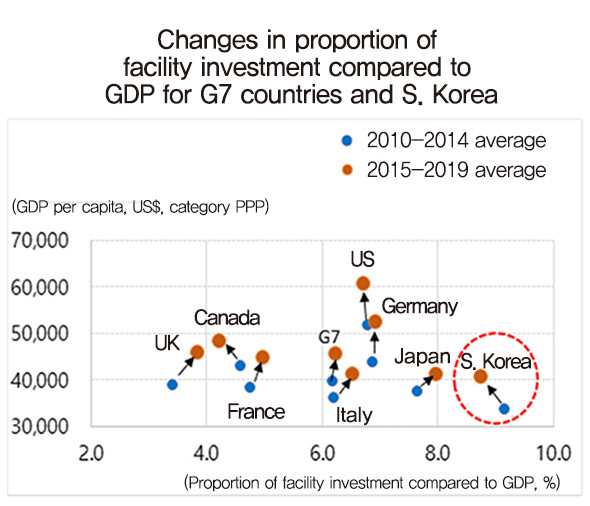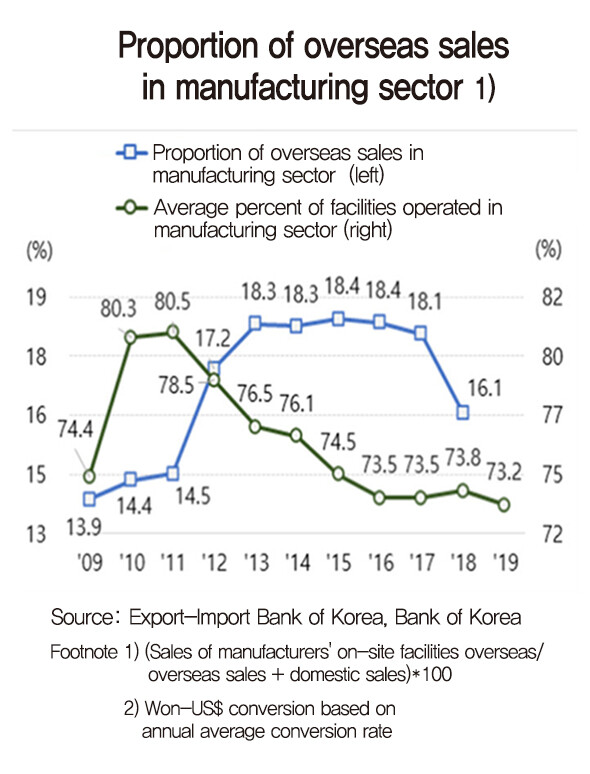hankyoreh
Links to other country sites 다른 나라 사이트 링크
S. Korea has higher facility investment rate than G7 countries, but still relies on machinery imports

While South Korea has boasted the highest rate of facility investment relative to economic scale compared to the G7 countries over the past 15 years, the country has become increasingly dependent on machinery imports rather than domestic shipments, although machinery is one of the main capital goods for facility investment, a study shows.
On July 19, Hyundai Research Institute (HRI) published an empirical analysis of the South Korean economy from 2005 to 2019 in a report titled, “The Effects of Uncertainty on Facility Investment.” A comparison with the G7 countries’ average annual facility investment as a percentage of gross domestic product (GDP) for the periods 2010-2014 and 2015-2019 showed changes of 9.2% to 8.8% for South Korea, 4.6% to 4.2% for Canada, 6.8% to 6.7% for the US, 3.4% to 3.9% for the UK, 6.2% to 6.5% for Italy, 7.7% to 8.0% for Japan, and 4.8% to 5.0% for France, with Germany’s rate remaining in place at 6.9%. At around 9%, South Korea ranked highest for facility investment as a percentage of economic scale.
But in the area of machinery -- which accounts for the bulk of facility investment goods at 72% -- South Korea was found to be increasingly reliant on imports rather than domestically produced shipments. In terms of the machinery index (where “100” represents 2005 levels,” the import index rose all the way to 223.5 for 2017, while the domestic shipment index showed a low rate of increase at 136.8. For 2019, the import index stood at 194.5 and the domestic demand index at 116.7. The report said, “In the area of machinery, imports have continued to increase without any significant expansion in domestic shipments, which has functioned as a constraint on domestic investment demand.”
An observation of trends in facility investment involving overseas markets, the percentage of overseas market sales in the area of manufacturing (sales from overseas branches among total sales for domestic and overseas manufacturing corporations) rose from 13.9% in 2009 to 18.4% in 2016 (16.1% as of 2018). In contrast, the average operation rate for domestic manufacturing slid from 80.5% in 2011 to 73.2% in 2019. HRI explained, “The decline in average domestic manufacturing operation rates and the increased percentage of overseas market sales will function as factors inhibiting domestic facility investment.”

Seven indicators -- including real GDP, real interest rates, and expanded foreign direct investment – were also analyzed for their effects on investment over the period from the first quarter of 2005 to the fourth quarter of 2019. The results showed an estimated 0.51-percentage point rise in the rate of increase in facility investment with each percentage point increase in the economic growth rate (with a ripple effect from the third quarter afterward on average), with an estimated 0.38-percentage point rise with each percentage point increase in the Business Survey Index (BSI).
Changes in the real interest rate and net investment capital outflows (foreign direct investment minus direct domestic investment by foreign investors) were not found to have a significant effect on the rate of increase in facility investment. This suggests that facility investment decisions by South Korean manufacturing businesses are mainly reliant on the growth rate and business fluctuation indicators rather than interest rates or overseas investment factors.
By Cho Kye-wan, staff reporter
Please direct comments or questions to [english@hani.co.kr]

Editorial・opinion
![[Editorial] Does Yoon think the Korean public is wrong? [Editorial] Does Yoon think the Korean public is wrong?](https://flexible.img.hani.co.kr/flexible/normal/500/300/imgdb/original/2024/0417/8517133419684774.jpg) [Editorial] Does Yoon think the Korean public is wrong?
[Editorial] Does Yoon think the Korean public is wrong?![[Editorial] As it bolsters its alliance with US, Japan must be accountable for past [Editorial] As it bolsters its alliance with US, Japan must be accountable for past](https://flexible.img.hani.co.kr/flexible/normal/500/300/imgdb/original/2024/0417/6817133413968321.jpg) [Editorial] As it bolsters its alliance with US, Japan must be accountable for past
[Editorial] As it bolsters its alliance with US, Japan must be accountable for past- [Guest essay] Amending the Constitution is Yoon’s key to leaving office in public’s good graces
- [Editorial] 10 years on, lessons of Sewol tragedy must never be forgotten
- [Column] A death blow to Korea’s prosecutor politics
- [Correspondent’s column] The US and the end of Japanese pacifism
- [Guest essay] How Korea turned its trainee doctors into monsters
- [Guest essay] As someone who helped forge Seoul-Moscow ties, their status today troubles me
- [Editorial] Koreans sent a loud and clear message to Yoon
- [Column] In Korea’s midterm elections, it’s time for accountability
Most viewed articles
- 1[Column] The clock is ticking for Korea’s first lady
- 2Samsung barricades office as unionized workers strike for better conditions
- 3[Editorial] When the choice is kids or career, Korea will never overcome birth rate woes
- 4Why Israel isn’t hitting Iran with immediate retaliation
- 5[News analysis] After elections, prosecutorial reform will likely make legislative agenda
- 6[Editorial] Does Yoon think the Korean public is wrong?
- 7S. Korea, Japan reaffirm commitment to strengthening trilateral ties with US
- 8[Editorial] As it bolsters its alliance with US, Japan must be accountable for past
- 9Japan officially says compensation of Korean forced laborers isn’t its responsibility
- 10Faith in the power of memory: Why these teens carry yellow ribbons for Sewol